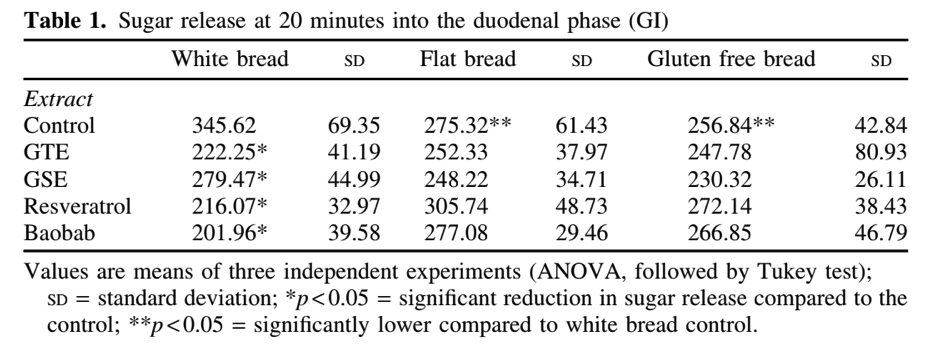Sugar release from various starch rich foods with added polyphenol extracts
Abstract:
The glycaemic index (GI) provides a measure of the increase in blood glucose (BG) levels after consumption of a food. Starch rich foods with high GI values cause a rapid rise in BG and frequent consumption of these types of foods can increase the risk of developing type 2 diabetes. Therefore, any compound that can decrease this rise in BG may prove beneficial in reducing the risk of certain disease states. Polyphenols are plant secondary metabolites found ubiquitously in plants and have been found to reduce the release of sugars for absorption into the body from starch rich foods, either by inhibiting digestive enzymes(1) or by binding to the starch molecules in the food and reducing their breakdown(2). Unpublished results from our lab have shown that certain polyphenol rich extracts such as green tea extract (GTE), grape seed extract (GSE), resveratrol and baobab fruit extract have been shown to decrease the amount of reducing sugars released from white bread (GI of 100) after being baked into the bread. The aim of this study was to determine if the same four polyphenol rich extracts could reduce sugar release from other medium/high GI, starch rich foods such as white flatbread (GI of approximately 72) and gluten free white bread (GI of approximately 70).
Extracts were baked into all starch food systems at GTE 0.40%, GSE 0.20%, Baobab fruit 1.88% and Resveratrol 0.22%. The in vitro digestion method adapted by Mishra & Monro(3) was used, followed by a colourimetric method by Englyst & Hudson(4) to determine total reducing sugars released throughout digestion at the salivary phase, the gastric phase and 20, 60 and 120 minutes into the duodenal phase. Sugar release at 20 minutes into the duodenal phase was considered the stage corresponding to GI and was therefore used to measure any reduction in sugar release(5). Sugar release was expressed in mg per gram of bread sample.

All extracts significantly (p<0.05) reduced sugar release from white bread at 20 minutes into duodenal digestion. There was no reduction in 20 minute sugar release for any of the extracts, in either the flat bread or the gluten free bread, compared to the control. Polyphenol rich extracts can reduce the release of sugar available for absorption only from certain high GI starch rich foods, and therefore show potential in reducing the glycaemic response in humans. Future work will look at increasing the dose of extract added into foods on sugar release, and also at the potential of polyphenols on sugar release from other medium to high GI, starch rich foods.
1. Tadera K, Minami Y, Takamatsu K & Matsuoka T (2006) J Nutr Sci Vitamin, 52, 149–153.
2. Yuste P, Longstaff M & McCorquodale C (1992) Brit J Nutr, 67, 57–65.
3. Mishra S & Monro JA (2009) J Cereal Sci, 50, 61–66.
4. Englyst HN & Hudson GJ (1987) Food Chem, 24, 63–76.
5. Englyst KN, Englyst HN, Hudson GJ, Cole TJ & Cummings JH (1999) AJCN, 69, 448–454.
Copyright©2013 Proceedings of the Nutrition Society
Authors:
Shelly Coe
- Functional Food Centre, Department of Sport and Health Sciences, Oxford Brookes University, Gipsy Lane, Headington, Oxford OX3 0BP, UK
Lisa Ryan
- Functional Food Centre, Department of Sport and Health Sciences, Oxford Brookes University, Gipsy Lane, Headington, Oxford OX3 0BP, UK









